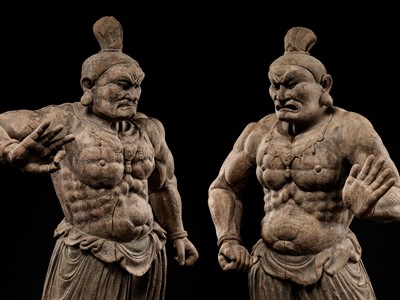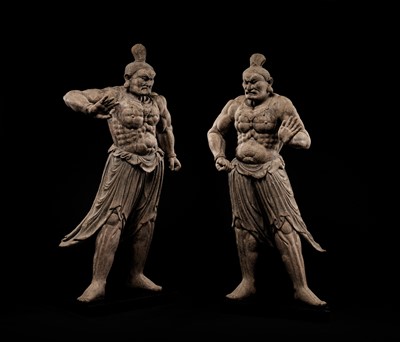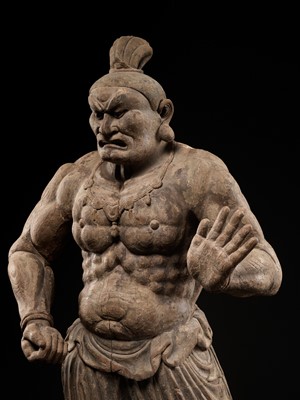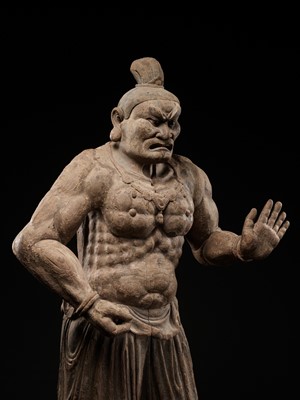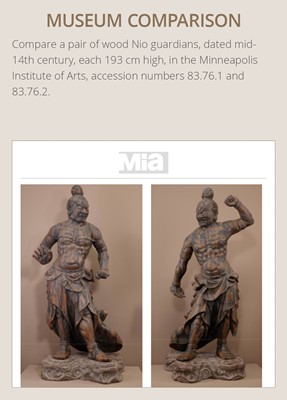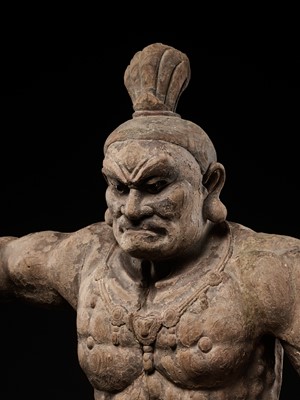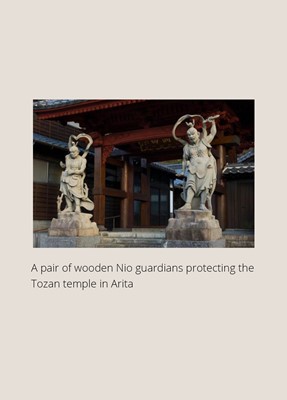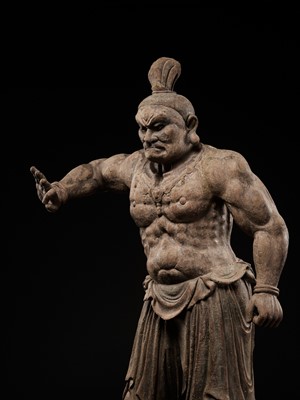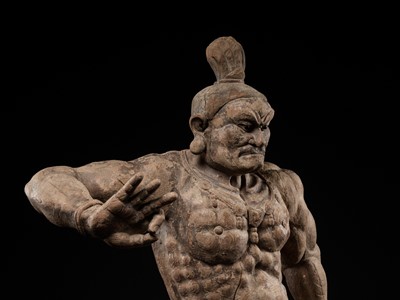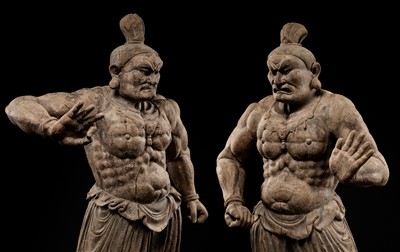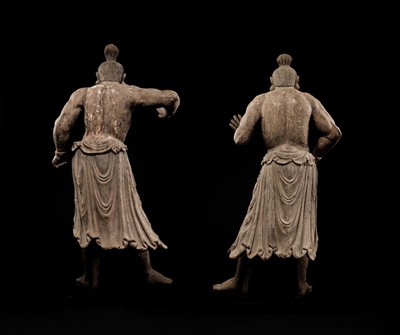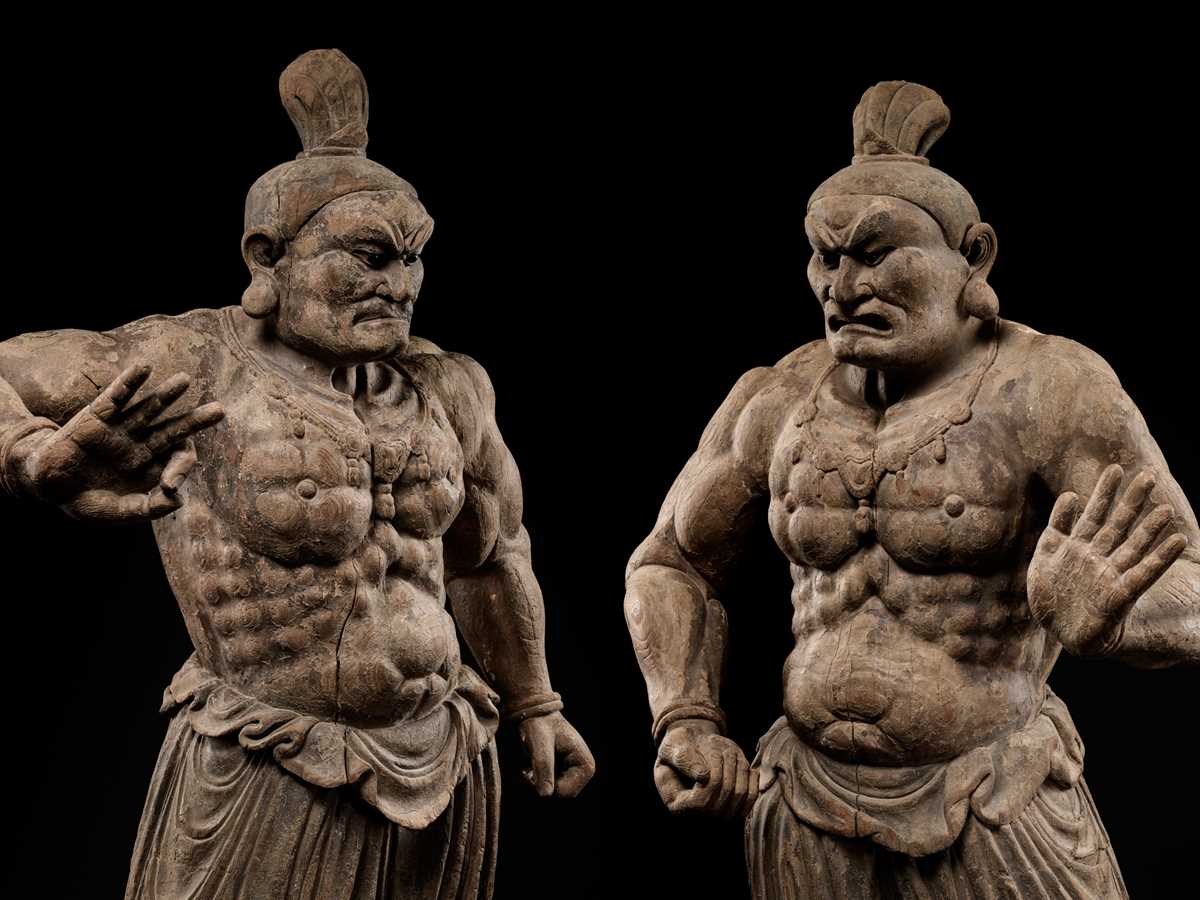16th Jun, 2023 11:00
Fine Japanese Art
47
AN EXCEPTIONAL PAIR OF MONUMENTAL WOOD FIGURES OF NIO GUARDIANS
Sold for €58,500
including Buyer's Premium
Japan, Edo period (1615-1868)
Each finely carved and decorated with gesso and pigment to depict a Nio guardian, Agyo with the mouth open, holding a tama (sacred jewel) in his lowered right hand, his left hand extended with the palm facing forward, in a protective gesture akin to the abhaya mudra, Ungyo with the mouth closed, his right hand extended with the thumb and index finger joined similar to vitarka mudra. Both are wearing flowing skirts with deeply carved folds, gathered at the waist revealing their strong muscular bodies, and adorned with necklaces. Their faces showing fierce expressions and well detailed with thick brows, strong cheeks, and large black glass eyes, flanked by thick pendulous earlobes. Each with the hair drawn up into a high chignon.
HEIGHT 205 cm (each excl. base) and 214 cm (incl. base)
Condition: Good condition, commensurate with age. Extensive wear, flaking and losses to gesso and pigment, expected age cracks, minor chips, small losses.
Provenance: A private collection of Japanese and Southeast Asian Buddhist art. A private collection in the United Kingdom, gifted from the above during the 1980s.
Each figure is supported on an associated metal base of rectangular form.
Nio or Kongorikishi are two wrathful and muscular guardians of the Buddha standing today at the entrance of many Buddhist temples in East Asian Buddhism in the form of frightening wrestler-like statues. They are dharmapala manifestations of the bodhisattva Vajrapani, the oldest and most powerful deity of the Mahayana Buddhist pantheon. According to Japanese tradition, they traveled with Gautama Buddha to protect him. Within the generally pacifist tradition of Buddhism, stories of dharmapalas justified the use of physical force to protect cherished values and beliefs against evil. Nio are also seen as a manifestation of Mahasthamaprapta, the bodhisattva of power that flanks Amitabha in Pure Land Buddhism and as Vajrasattva in Tibetan Buddhism. They are usually a pair of figures that stand under a separate temple entrance gate, usually called Niomon in Japan.
Guhyapada (Japanese: Misshaku Kongo) is a symbol of overt violence: he wields a vajra mallet and bares his teeth. His mouth is depicted as being in the shape necessary to form the ‘ha’ or ‘ah’ sound, wherefore he is also known as Agyo in Japan. Narayana (Naraen Kongo) is depicted either bare-handed or wielding a sword. He symbolizes latent strength, holding his mouth tightly shut. His mouth is rendered to form the sound ‘huṃ’, ‘heng’, or ‘un’. He is also referred to as Ungyo in Japanese due to his closed mouth.
Museum comparison:
Compare a pair of wood Nio guardians, dated mid-14th century, each 193 cm high, in the Minneapolis Institute of Arts, accession numbers 83.76.1 and 83.76.2.
Japan, Edo period (1615-1868)
Each finely carved and decorated with gesso and pigment to depict a Nio guardian, Agyo with the mouth open, holding a tama (sacred jewel) in his lowered right hand, his left hand extended with the palm facing forward, in a protective gesture akin to the abhaya mudra, Ungyo with the mouth closed, his right hand extended with the thumb and index finger joined similar to vitarka mudra. Both are wearing flowing skirts with deeply carved folds, gathered at the waist revealing their strong muscular bodies, and adorned with necklaces. Their faces showing fierce expressions and well detailed with thick brows, strong cheeks, and large black glass eyes, flanked by thick pendulous earlobes. Each with the hair drawn up into a high chignon.
HEIGHT 205 cm (each excl. base) and 214 cm (incl. base)
Condition: Good condition, commensurate with age. Extensive wear, flaking and losses to gesso and pigment, expected age cracks, minor chips, small losses.
Provenance: A private collection of Japanese and Southeast Asian Buddhist art. A private collection in the United Kingdom, gifted from the above during the 1980s.
Each figure is supported on an associated metal base of rectangular form.
Nio or Kongorikishi are two wrathful and muscular guardians of the Buddha standing today at the entrance of many Buddhist temples in East Asian Buddhism in the form of frightening wrestler-like statues. They are dharmapala manifestations of the bodhisattva Vajrapani, the oldest and most powerful deity of the Mahayana Buddhist pantheon. According to Japanese tradition, they traveled with Gautama Buddha to protect him. Within the generally pacifist tradition of Buddhism, stories of dharmapalas justified the use of physical force to protect cherished values and beliefs against evil. Nio are also seen as a manifestation of Mahasthamaprapta, the bodhisattva of power that flanks Amitabha in Pure Land Buddhism and as Vajrasattva in Tibetan Buddhism. They are usually a pair of figures that stand under a separate temple entrance gate, usually called Niomon in Japan.
Guhyapada (Japanese: Misshaku Kongo) is a symbol of overt violence: he wields a vajra mallet and bares his teeth. His mouth is depicted as being in the shape necessary to form the ‘ha’ or ‘ah’ sound, wherefore he is also known as Agyo in Japan. Narayana (Naraen Kongo) is depicted either bare-handed or wielding a sword. He symbolizes latent strength, holding his mouth tightly shut. His mouth is rendered to form the sound ‘huṃ’, ‘heng’, or ‘un’. He is also referred to as Ungyo in Japanese due to his closed mouth.
Museum comparison:
Compare a pair of wood Nio guardians, dated mid-14th century, each 193 cm high, in the Minneapolis Institute of Arts, accession numbers 83.76.1 and 83.76.2.
Zacke Live Online Bidding
Our online bidding platform makes it easier than ever to bid in our auctions! When you bid through our website, you can take advantage of our premium buyer's terms without incurring any additional online bidding surcharges.
To bid live online, you'll need to create an online account. Once your account is created and your identity is verified, you can register to bid in an auction up to 12 hours before the auction begins.
Intended Spend and Bid Limits
When you register to bid in an online auction, you will need to share your intended maximum spending budget for the auction. We will then review your intended spend and set a bid limit for you. Once you have pre-registered for a live online auction, you can see your intended spend and bid limit by going to 'Account Settings' and clicking on 'Live Bidding Registrations'.
Your bid limit will be the maximum amount you can bid during the auction. Your bid limit is for the hammer price and is not affected by the buyer’s premium and VAT. For example, if you have a bid limit of €1,000 and place two winning bids for €300 and €200, then you will only be able to bid €500 for the rest of the auction. If you try to place a bid that is higher than €500, you will not be able to do so.
Online Absentee and Telephone Bids
You can now leave absentee and telephone bids on our website!
Absentee Bidding
Once you've created an account and your identity is verified, you can leave your absentee bid directly on the lot page. We will contact you when your bids have been confirmed.
Telephone Bidding
Once you've created an account and your identity is verified, you can leave telephone bids online. We will contact you when your bids have been confirmed.
Classic Absentee and Telephone Bidding Form
You can still submit absentee and telephone bids by email or fax if you prefer. Simply fill out the Absentee Bidding/Telephone bidding form and return it to us by email at office@zacke.at or by fax at +43 (1) 532 04 52 20. You can download the PDF from our Upcoming Auctions page.
How-To Guides
How to Create Your Personal Zacke Account
How to Register to Bid on Zacke Live
How to Leave Absentee Bids Online
How to Leave Telephone Bids Online
中文版本的操作指南
创建新账号
注册Zacke Live在线直播竞拍(免平台费)
缺席投标和电话投标
Third-Party Bidding
We partner with best-in-class third-party partners to make it easy for you to bid online in the channel of your choice. Please note that if you bid with one of our third-party online partners, then there will be a live bidding surcharge on top of your final purchase price. You can find all of our fees here. Here's a full list of our third-party partners:
- 51 Bid Live
- EpaiLive
- ArtFoxLive
- Invaluable
- LiveAuctioneers
- the-saleroom
- lot-tissimo
- Drouot
Please note that we place different auctions on different platforms. For example, in general, we only place Chinese art auctions on 51 Bid Live.
Bidding in Person
You must register to bid in person and will be assigned a paddle at the auction. Please contact us at office@zacke.at or +43 (1) 532 04 52 for the latest local health and safety guidelines.
